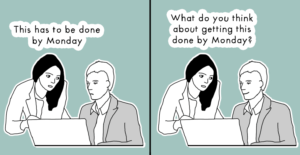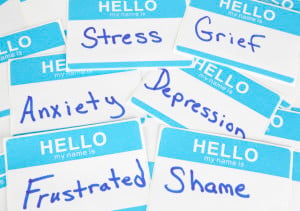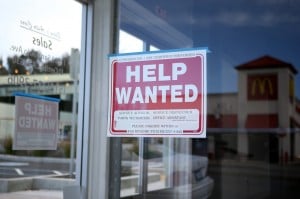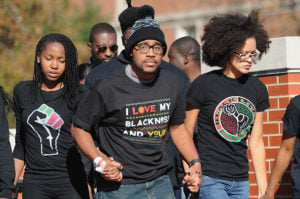
Mizzou students, including Jonathan Butler, holding hands in front of an obstructed brick structure.
I know many of us are counting the days until the midterm elections. I’m with you. These are not normal times.
I’m going to reveal a secret that may provide some comfort – a secret many civics teachers will never tell their classes. In fact, I will likely be expelled from the secret order of civics teachers for writing this: Voting is overrated.
I don’t deny that voting has elected into office folks like Washington Governor Jay Inslee, who led the fight to freeze – for the time being, anyway – Trump’s discriminatory travel ban on seven majority-Muslim countries that have wreaked far less havoc on Americans than armed toddlers.
I don’t deny that voting has elected into office a city council that unanimously cut its ties with Wells Fargo – a relationship worth billions – for, among many reasons, its financing of the Dakota Access Pipeline.
Nevertheless, these actions are hardly the norm for our elected officials. It has taken abnormal times to spur such action. Voting, alone, rarely gets you there.
I don’t assert this to minimize the struggles of so many marginalized groups to gain voting rights. (Keep in mind, though, these voting rights have never been won directly through a vote by the people.)
And I don’t say this to take our attention away from the egregious voter suppression efforts since the gutting of the Voting Rights Act in 2013. (For example, the Supreme Court ruled in the summer of 2016 that North Carolina’s suppression efforts targeted Black voters with “almost surgical precision.”)
Yes, I agree that voting is important and everyone should have the right to vote. However, when I think of many of the recent wins for social justice that I’ve been tracking, the vote by the people rarely factors in.
And that’s probably always been true.
That may be why Mother Jones, the organizer and agitator who Teddy Roosevelt once called “The Most Dangerous Woman in America,” stayed clear of the suffrage movement. In her biography, she said, “I have no vote. And I’ve raised hell all over the country.”
That may be why Lucy Gonzales Parsons, labor organizer, once said, “Never be deceived that the rich will allow you to vote away their wealth.”
That could be why Emma Goldman, feminist and anarchist, once cautioned us against expecting too much from women winning the right to vote – given that, for men, “every inch of ground he has gained has been through a constant fight, a ceaseless struggle for self-assertion, and not through suffrage.”
Goldman’s point echoes one made years earlier by Frederick Douglass, the formerly enslaved abolitionist who Trump recently claimed is someone “who’s done an amazing job and is getting recognized more and more, I notice.”
Douglass, actually long deceased, once said, “This struggle may be a moral one, or it may be a physical one, and it may be both moral and physical, but it must be a struggle. Power concedes nothing without a demand. It never did, and it never will.”
Does filling out some ovals (maybe) once a year really constitute “struggle?” If you believe Douglass – that there is no progress without struggle – then you already know the answer.
Voting may get you something, but other forms of pressure – what union folk might call “direct action” – will get you a whole lot more a whole lot sooner.
The following stories provide compelling evidence of that fact, as well as lots of ideas for action.
They are, for the most part, stories about winning against racism – which are especially relevant now, with the confirmation of Jeff Sessions and the rise of Steven Bannon arguably turning the White House into the White Supremacy House.
Our resistance must be persistent.
1. Those Times Students Won Against Racist Institutions of Higher Learning
A history of racism directed at Black students at the University of Missouri sparked movements across campuses nationwide in the fall of 2015. The outrage that fueled this movement never, to my knowledge, sought an outlet in the form of a ballot.
After Black students at Mizzou endured the repeated use of racial slurs against them, and after swastikas were written using ashes and feces, and after insufficient responses by administrators to address these acts of violence, Jonathan Butler – and other Black students – had had enough.
In November 2015, Butler launched a hunger strike, arguing that President Tim Wolfe failed to address the racist culture at Mizzou. A student boycott to support Butler quickly followed.
After Wolfe told students that “systemic oppression is because you don’t believe that you have the equal opportunity for success,” Black football players joined the fight, refusing to practice or play until Wolfe resigned.
He resigned the next day.
It’s important to remember that a courageous act alone is powerful – but alone, may not be enough.
A courageous act needs followers, illustrated well by this short TED Talk. And when those followers, like Division I football players, have the power to disrupt the cash flow of those in power, results will follow.
A similar situation took place at Seattle University. I include it not only because it, too, inspires, but also because I’m confident that few are willing to lead hunger strikes like Jonathan Butler did. Or the four undergrads who fought to preserve funding for San Francisco State University’s College of Ethnic Studies.
At Seattle University, it was a 24-day sit-in, not a hunger strike, that toppled a problematic humanities dean who created a “hostile” environment for students of color.
2. That Time Educators Drove Out Racist Hate From Their Schools
Despite its progressive reputation, Seattle has long underserved its Black students.
Much like the rest of the nation, Seattle has subjected Black students to higher rates of suspension and expulsion than white students for decades. In 2001, the NAACP considered legal action against the district.
In 2015, data showed that Black students were four times as likely to be suspended as white students. Desperate measures were long overdue.
In the fall of 2016 at John Muir Elementary, educators, many donning Black Lives Matter shirts, partnered with a local group called Black Men Uniting to Change the Narrative.
Together, they planned to welcome their majority Black population with high fives, ensuring students would “see positive images of Black people and people of color in their community.”
When the media caught wind of this event, the threats started rolling in. One was a bomb threat.
Union members responded by calling on all Seattle schools to wear Black Lives Matter T-shirts. On October 19, 2016, over 2,000 educators donned Black Lives Matter shirts to support their students and John Muir Elementary.
Check out the video for images from this unprecedented action. This time, there were no bomb threats.
When it’s just one that pushes against the status quo, that one can, too, easily become a target. If everyone joins in, there are simply too many targets to threaten.
The action in Seattle has since inspired similar events in Bellevue, Philadelphia, and Rochester.
3. Those Times People with Computers Chipped Away at Racism and White Nonsense
Much of the segregation we continue to feel today in metropolitan areas is the legacy of “government engineered” efforts.
Black Americans and other groups of color were barred from houses in the suburbs that appreciated, astronomically, before they could finally legally purchase them.
Rectifying such practices would require reparations of hundreds of thousands of dollars – per family.
Artist Natasha Marin, knowing that such reparations were as likely as getting her “40 acres and a mule,” decided not to wait. She launched a Facebook page, now a website called Reparations, on which people of color can make requests and white people can offer services and goods.
While the list of “satisfied” requests grows, writer Reagan Jackson argues that “the magic of the page lay in the connection” among those using Marin’s creation.
Terri Kempton and Layla Tromble, two white Americans, also decided they had had enough waiting.
Fed up with systemic racism, the racialized nonsense coming out of white people, and the toll such nonsense had taken on their friends of color, they created White Nonsense Roundup, to “round up” the rampant racism perpetuated by white Americans on social media.
With a team of over sixty volunteers working around the clock, they created a “roving band of white allies coming to assist people of color when racist people say destructive and terrible things on social media.”
And it’s working.
Volunteers are full of success stories: One recounts the day she changed the mindset of a British skinhead on Twitter. Another recalls intervening with a white woman who initially called changing Columbus Day to Indigenous People’s Day “PC crap” that had gone too far.
Afterwards, the rounded-up woman redirected her anger at the educational system for not teaching her more Native perspectives. One white person who at first seemed intractable, later messaged the volunteer, “I was wrong and [the volunteer] was right.”
You can’t fix everything, but you can do something. Like Reparations and White Nonsense Roundup, there’s a transformative idea not yet found. Find it.
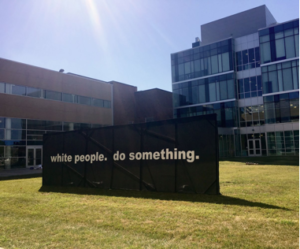
An art piece by Kara Springer of Temple University’s School of Art reads in white text on a black background, “white people. do something.”
4. That Time Black Lives Matter Won the First Racial Justice Platform by a Presidential Candidate
Bernie Sanders may have seemed like the candidate most likely to support racial justice, but – for much of his campaign – he prioritized issues of class over issues of race. That is, until Black Lives Matter activists had had enough of their issues being relegated to the back burner.
In the wake of Sandra Bland’s death, activists interrupted Bernie Sanders on stage at Netroots Nation – a political convention for progressives. Sanders responded defensively and “blew an opportunity” to better understand the racism that Black and Brown people face.
Fast forward a month to Seattle. Two Black women interrupted Sanders before he could give his speech and – in the process – exposed the racism of “liberal Seattle.” (One “progressive” actually shouted, “Taze her!”)
That same night, Bernie Sanders released a new tab on his campaign’s website titled “Racial Justice.” The tab linked to a page that read, “We need a societal transformation to make it clear that [B]lack lives matter and racism cannot be accepted in a civilized country.”
It took persistent disruption, not decorum, to get represented by a progressive.
Imagine how much disruption the Trump administration will need.
We are starting to learn the answer.
5. Those Times People Resisted Trump at Every Turn
Vox reports our continued resistance – “protests, phone calls, and mobilization” – is working.
And the Resistance Report suggests the same thing when documenting victories from two days of pressure – that is, swaying two Republican senators to oppose Betsy DeVos’ confirmation to pressuring Nordstrom to pull Ivanka Trump’s products.
Using extensive academic research, Fusion makes a compelling case that protests indeed have a positive impact. In this digital age, there’s no shortage of resources on how to protest effectively.
We need to keep up the resistance.
Join it if you haven’t already. If you have, make sure more of your sphere of influence is joining with you.
***
As I’ve argued before, the amount of pressing issues is overwhelming. At the same time, this fact makes it relatively easy to find a struggle to join. There are so many stories of victories from which to draw inspiration.
Even a dictionary is inspired to get off the shelf and resist.
Run for school board. Form a neighborhood group. Create art.
But do something.
We need more than your ballot in two years.
We need you now.
[do_widget id=’text-101′]
Jon Greenberg is a Contributing Writer for Everyday Feminism. He is an award-winning public high school teacher in Seattle who has gained broader recognition for standing up for racial dialogue in the classroom — with widespread support from community — while a school district attempted to stifle it. To learn more about Jon Greenberg and the Race Curriculum Controversy, visit his website. You can also follow him on Facebook, Tumblr, and Twitter @citizenshipsj. Read his articles here.
Search our 3000+ articles!
Read our articles about:
Our online racial justice training
Used by hundreds of universities, non-profits, and businesses.
Click to learn more





